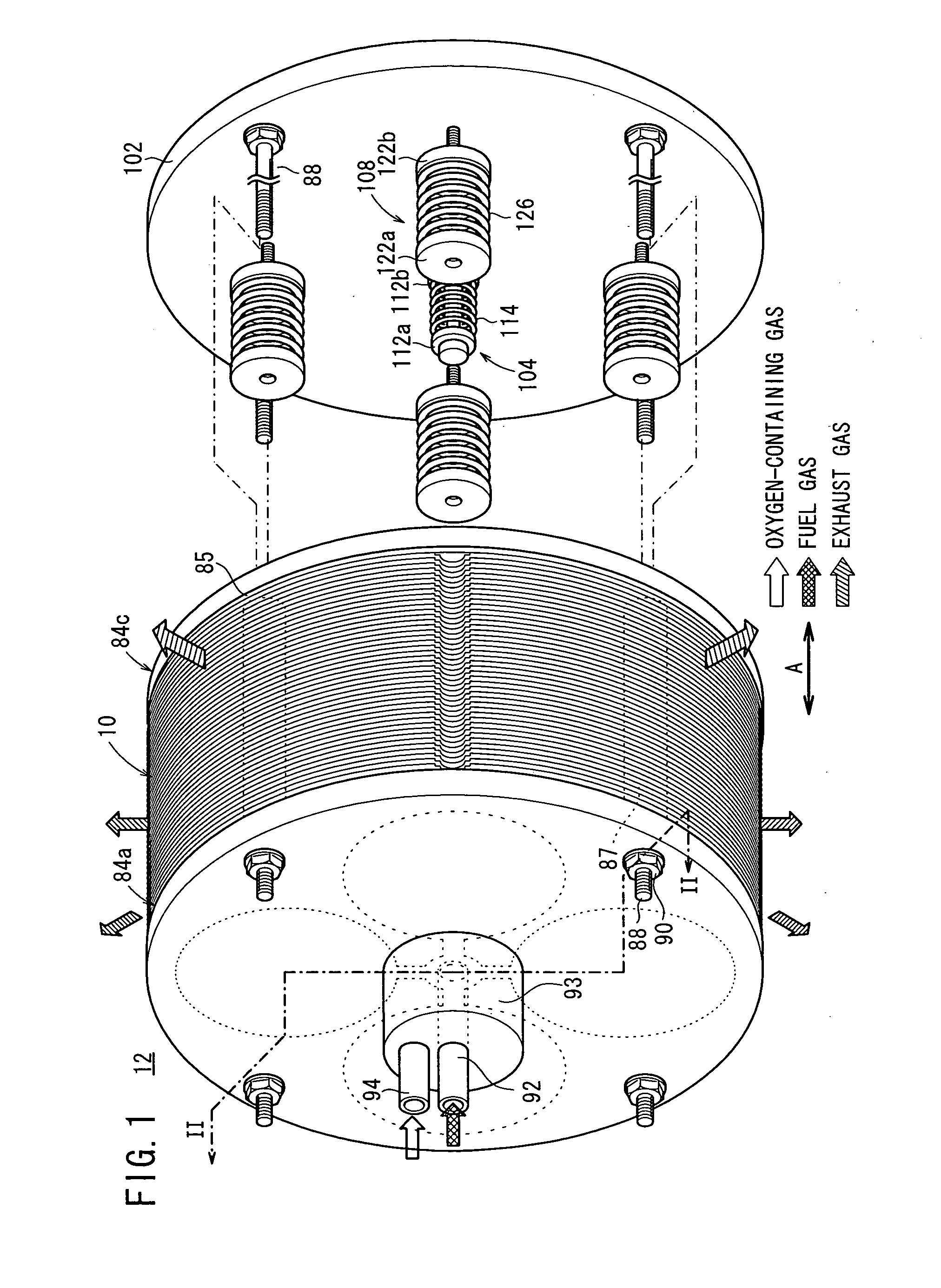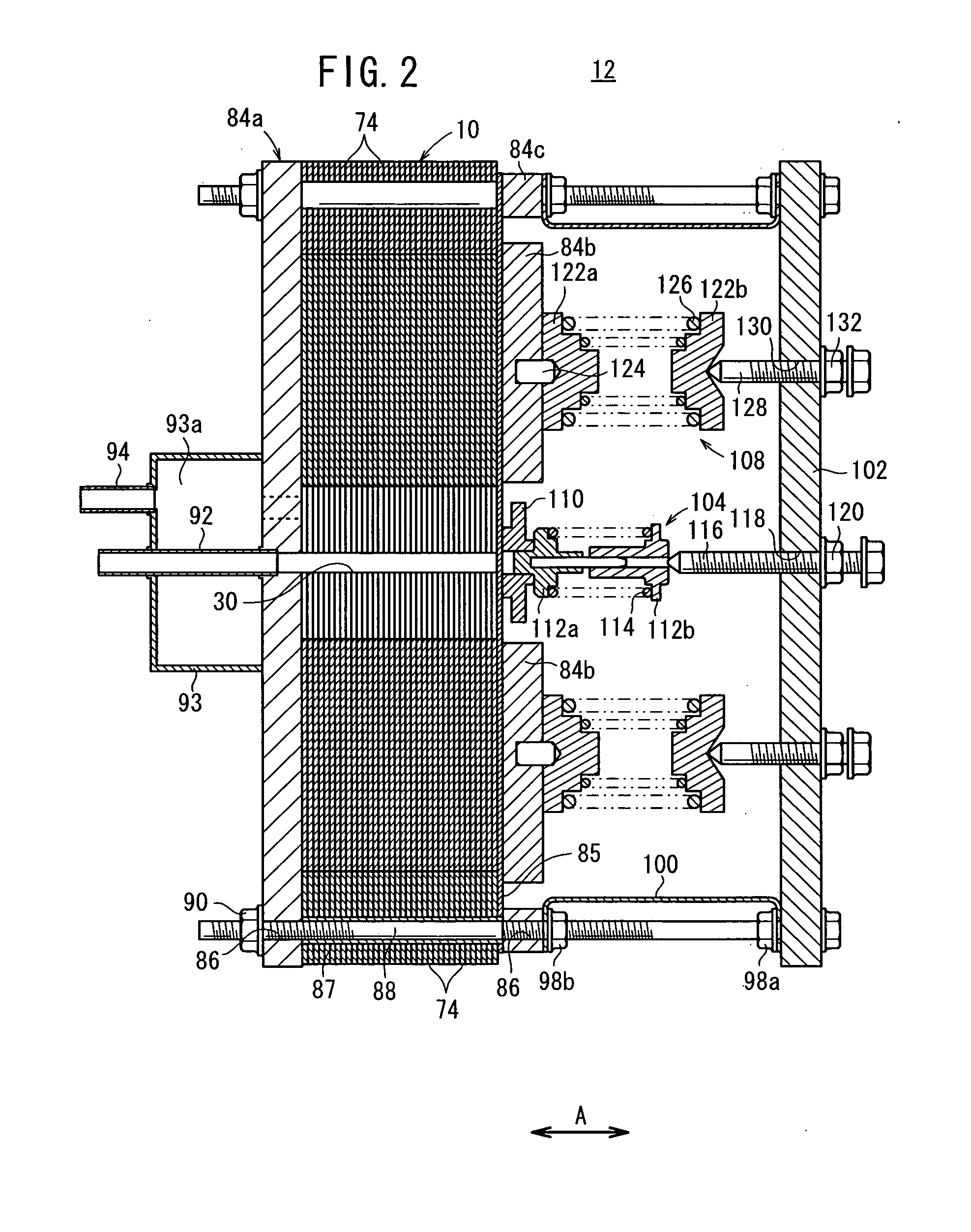Fuel cell and fuel cell stack
a fuel cell and stack technology, applied in the field of fuel cells, can solve the problems of easy damage or cracking of electrolyte electrode assemblies, inability to efficiently perform power generation of the entire fuel cell, and inability to prevent damage or cracking of the electrolyte electrode assembly, so as to prevent damage or cracking, improve heat efficiency, and suppress the radiation of heat generated
- Summary
- Abstract
- Description
- Claims
- Application Information
AI Technical Summary
Benefits of technology
Problems solved by technology
Method used
Image
Examples
first embodiment
[0045]FIG. 1 is a perspective view schematically showing a fuel cell stack 12 formed by stacking fuel cells 10 according to the present invention in a direction indicated by an arrow A. FIG. 2 is a cross sectional view showing the fuel cell stack 12 taken along a line II-II in FIG. 1.
[0046]The fuel cell 10 is a solid oxide fuel cell (SOFC) used in various applications, including stationary and mobile applications. For example, the fuel cell 10 is mounted on a vehicle. As shown in FIGS. 3 and 4, the fuel cell 10 includes electrolyte electrode assemblies (MEAs) 26. Each of the electrolyte electrode assemblies 26 includes a cathode 22, an anode 24, and an electrolyte (electrolyte plate) 20 interposed between the cathode 22 and the anode 24. For example, the electrolyte 20 is made of ion-conductive solid oxide such as stabilized zirconia. The electrolyte electrode assembly 26 has a circular disk shape. A barrier layer (not shown) is provided at least at the outer circumferential edge of...
second embodiment
[0096]In the second embodiment, the flow rectifier member 136 is made of heat insulating material. Therefore, radiation of heat generated in the electrolyte electrode assemblies 26 to the outside of the sandwiching sections 36 is suppressed. Thus, it is possible to improve heat efficiency easily.
[0097]Further, the space L3 between the adjacent flow rectifier members 136 near the oxygen-containing gas inlet of the electrolyte electrode assembly 26 is smaller than the space L4 between the adjacent flow rectifier members 136 near the oxygen-containing gas outlet of the electrolyte electrode assembly 26. In the structure, the oxygen-containing gas flows smoothly on the electrolyte electrode assembly 26, and the pressure loss is reduced effectively.
[0098]In the second embodiment, the flow rectifier member 136 is made of heat insulating material. Alternatively, the flow rectifier member 136 may be made of electrically insulating material, and the flow rectifier member 74 may be made of he...
third embodiment
[0099]FIG. 10 is an exploded perspective view showing a fuel cell 140 according to the present invention.
[0100]The fuel cell 140 includes separators 28, and a mesh member (electrically conductive woven fabric such as metal mesh) 142 instead of the plate 50 is provided on the surface 36b of each of the sandwiching sections 36 of the separators 28 (see FIGS. 10 and 11). An oxygen-containing gas channel 54 is formed in the mesh member 142. A cutout 142a is formed in the mesh member 142 as a space for providing the second bridge 64 of the channel member 60.
[0101]In the third embodiment, the same advantages as in the case of the first and second embodiments are obtained. Though the mesh member 142 is used in the third embodiment, instead of the mesh member 142, for example, an electrically conductive felt member (electrically conductive non-woven fabric such as metal felt), foam metal, expanded metal, punching metal, or pressed embossed metal may be used.
PUM
 Login to View More
Login to View More Abstract
Description
Claims
Application Information
 Login to View More
Login to View More - R&D
- Intellectual Property
- Life Sciences
- Materials
- Tech Scout
- Unparalleled Data Quality
- Higher Quality Content
- 60% Fewer Hallucinations
Browse by: Latest US Patents, China's latest patents, Technical Efficacy Thesaurus, Application Domain, Technology Topic, Popular Technical Reports.
© 2025 PatSnap. All rights reserved.Legal|Privacy policy|Modern Slavery Act Transparency Statement|Sitemap|About US| Contact US: help@patsnap.com



